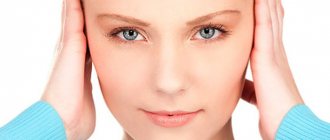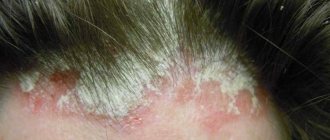Glaucoma:
Throbbing pain on the right side of the head can begin in those who have a disease such as glaucoma. In this case, a person feels an increase in intraocular pressure, during which the eyes hurt, the eyelids turn red, nausea, weakness appear, and vision deteriorates. The insidiousness of this disease is that at first it does not manifest itself in any way.
If throbbing pain in the head is present in the back of the head, then it may indicate some kind of infectious disease, or if there are tumors in the brain. But these diseases can be reliably stated when pulsation occurs regularly. If these are isolated cases, they occur in the following conditions:
- when a person drank coffee and abruptly gave it up. Ripple occurs because the vessels cannot quickly return to normal after an overstrained state;
- when smoking;
- during an incorrect position during sleep;
- after experiencing overvoltages of various types.
Such pain goes away when a person quits smoking, gives up coffee and is less nervous about various little things.
Types of throbbing pain in the head in various diseases
If a person focuses on his sensations in the back of his head, understands how long the pulsation lasts and what its frequency is, he can himself determine the presence of a particular disease.
- If the pulsation begins in the morning and there is a feeling of heaviness in the head and an increased heart rate, this is a sign of pressure changes, often hypertension. In some cases, along with these signs, pain in the temples is observed.
- Regular pulsation in the temples of the head indicates the presence of VSD. Often dizziness and nausea are added to the pulsation.
- A slight throbbing pain in the back of the head and a feeling that the pain is radiating to the ear or jaw is the result of hypothermia or the onset of a cold or infection.
- Pulsation in the back of the head and temporal part, as well as in the temples, and this pain is accompanied by weakness throughout the body, perhaps blood vessels are pinched somewhere or a spasm has occurred.
- Symptoms of cervical migraine are sudden attacks of pulsation, while flashes appear in the eyes.
- With cervical osteochondrosis, a strong pulsation occurs in the back of the head, in addition, it becomes dark in the eyes and noise in the ears appears.
- Pain in the back of the head, which spreads to the right side of the head, in the temple area, indicates a strong jump in intracranial pressure, migraine or vasospasm.
Causes of headaches that radiate to the eyes
Headaches that extend to the eyes are often localized in the frontal lobe. It may primarily occur due to circulatory disorders in the brain, vascular spasms, inflammatory and other processes. In some cases, it indicates ophthalmological problems and therefore requires different treatment tactics. Determining the cause is a key stage of treatment, but it is impossible to carry out all procedures at home. The Clinical Brain Institute specializes in such problems, and doctors will provide a consultation and a complete informative examination.
Migraine
Migraine is an acute headache. It occurs in attacks and can be associated with various factors. Many patients complain of meteorological dependence, that is, the occurrence of attacks when weather conditions change. Migraines can also worsen after prolonged physical activity and nervous tension, with lack of sleep and poor diet. It can be determined for a number of characteristic reasons:
- attacks are often unilateral, occur abruptly, and have moderate or high intensity;
- headache radiates to the eyes, intensifies when bright light hits the retina;
- nausea, weakness, deterioration in health are additional signs.
Migraine is a chronic condition with a relapsing course. It may first appear after trauma or concussion, as well as with damage to the cervical spine. In some cases, it becomes less pronounced or goes away completely over time, but many patients suffer from its manifestations in old age.
Pressure changes
Hypertension is an increase in blood pressure. It is often accompanied by chronic aching pain that spreads over the entire surface of the head and radiates into the eyes. This symptom can be determined at home, using a regular tonometer. Hypertension can be a consequence of physical exertion or emotional stress, as well as high temperature and many other factors. You can lower your blood pressure with medications, as prescribed by your doctor. For this disease, diuretics, calcium channel blockers and beta-blockers, as well as sedatives and other drugs are used.
Separately, there is an increase in intracranial pressure. This occurs when fluid accumulates in the cerebral ventricles and its outflow is disrupted. Normally, the circulation of cerebrospinal fluid (CSF) occurs continuously. It enters from the spinal canal into the ventricles of the brain, but does not stay here for long and is quickly removed through the venous sinuses. Intracranial pressure is a precise value that consists of the resistance of several fluids:
- blood that is in the cerebral arteries;
- cerebrospinal fluid;
- actual brain tissue.
Another indicator that needs to be measured when pain radiates into the eyes occurs is intraocular pressure. It is created by aqueous humor, and its increase causes visual impairment and pressing pain, which can spread to the patient's head. Chronic increase in intraocular pressure is called glaucoma and can lead to dangerous consequences - there is a risk of optic nerve atrophy and the development of blindness.
Intraocular pressure can be easily measured with a tonometer - this procedure is included in a standard ophthalmological examination. Intracranial pressure is difficult to determine, and accurate data can only be obtained by puncturing the cerebrospinal fluid. This procedure is painful and is performed only in extreme cases.
Diseases of the visual apparatus
Chronic eye strain is one of the most common causes of headaches. It especially often manifests itself in employees who spend a long time in front of a monitor, as well as in representatives of professions where it is necessary to focus on small objects for a long time. For such patients, it is enough to provide the eyes with short-term but regular rest, as well as perform exercises to develop the eye muscles.
Other illnesses that can cause headaches include:
- myopia or farsightedness;
- inflammation of the optic nerve is a dangerous condition that requires urgent medical attention;
- dry eye syndrome - decreased secretion of the lacrimal glands, including with increased air pollution.
The pain can be initially localized in the eyes, and then spread to the entire surface of the head. So, its cause is often damage or inflammation of the conjunctiva - the mucous membrane of the eyes. An attack of pressing pain may be associated with the entry of a foreign body, after which small marks remain on the mucous membrane. When trying to maintain the most comfortable position, the eye muscles are constantly in a tense position.
Injuries and their consequences
A concussion, open or closed craniocerebral injury necessarily manifests itself as an acute pain syndrome. Even a slight concussion causes visual disturbances, pain in the eyes and the appearance of black spots in the field of vision. Treatment tactics may vary depending on the type and severity of the injury. Painful sensations can occur not only during the period of treatment and rehabilitation, but also many years later. They are associated with impaired blood circulation and innervation in the affected areas of the brain, ischemia of nerve tissue and insufficiency of nerve conduction. The fight against long-term consequences is carried out with drugs to improve blood supply to the brain, with the obligatory abandonment of bad habits and lifestyle correction.
Infectious diseases
Colds, which develop due to the activation of pathogenic microflora, occur with headaches. It gets into the eyes, and photophobia and lacrimation may occur. Discomfort increases in bright light. Flu and acute respiratory viral infections are common, so many patients prefer to endure these diseases on their feet. However, they also require timely treatment and can lead to dangerous complications. Infectious diseases are manifested by characteristic symptoms:
- increased temperature (usually no more than 37.5 degrees);
- pressing headache that radiates to the eyes;
- weakness, decreased performance;
- discharge from the eyes and nose;
- Symptoms are worsened by bright lights or loud noises.
Infectious diseases should be distinguished from allergic reactions. An allergy is a pathological reaction of the human immune system. It mistakes normal substances for foreign substances and triggers defense mechanisms. Such substances can be any allergens, and headaches are most often caused by those that enter with inhaled air: dust, pollen, wool and others. Immune reactions occur with inflammation, redness and swelling of the mucous membranes. They are often accompanied by a nagging headache that spreads to the eyes. It is difficult for the patient to stay in a lit room - this causes an exacerbation of allergy symptoms.
Inflammation of the paranasal sinuses
Acute pain in the forehead that spreads to the eyes may be one of the symptoms of sinusitis. The paranasal sinuses are natural cavities in the skull filled with air. If the inflammatory process begins here with the proliferation of infection, they are filled with contents (serous, purulent, with impurities of blood). The most common form of sinusitis is sinusitis. The disease is an inflammation of the maxillary (maxillary) sinus and requires urgent treatment. If the contents of the maxillary sinus are not removed, there is a risk of complications in the form of meningitis (inflammation of the lining of the brain). This disease can be recognized by its characteristic signs:
- pressing pain, which is localized mainly in the frontal lobe of the head;
- the appearance of discharge from the eyes and nose;
- increased temperature, general weakness;
- increased pain when sharply tilting the head down and forward;
- A dull sound when tapping the maxillary sinuses indicates an accumulation of fluid or pus.
Another manifestation of sinusitis is frontal sinusitis, inflammation of the frontal sinus. Its symptoms are similar to those of sinusitis and are also accompanied by chronic headache, and the diagnosis can only be made on the basis of percussion data. When you tap the frontal sinuses (they are located behind the brow ridges and connect to the nasal cavity), a dull sound appears. which directly indicates the accumulation of contents.
Other causes of headaches that radiate to the eyes
One of the reasons why a headache appears and spreads to the eyes is the incorrect selection of lenses or glasses. These accessories should only be selected after an ophthalmological examination. If you wear lenses with unsuitable characteristics, as well as low-quality materials, this will lead to constant tension in the eye muscles and headaches. This may be caused by using expired lenses or failure to comply with one of the characteristics:
- lens material - modern models are made from the most suitable compounds, but they can also cause allergies and irritation of the mucous membranes;
- moisture content - lenses with a high water content are recommended for beginners, although they are easier to damage;
- oxygen permeability - this characteristic is higher in lenses designed for long-term wear;
- the diameter of the lens and the radius of its curvature - these indicators ensure a comfortable fit on the eyes, so the selection of lenses can only be carried out by an ophthalmologist.
Prolonged stay in a dusty room, in bright light or at high temperatures. This leads to dry eye syndrome and impaired secretion of the lacrimal glands. The same symptoms are observed with intense exposure to ultraviolet rays on the conjunctiva of the eye. Its damage causes acute headache, lacrimation and decreased visual acuity. The mucous membrane recovers over time, and during the treatment process it is recommended to reduce any stress on the eyes.
There is a throbbing pain in the head: when should you see a doctor?
There are situations in which a visit to the doctor is inevitable, and the sooner the better for a person to dull the pain at an early stage. So, you should visit a doctor if:
- The throbbing pain does not go away for several hours.
- Intense pain does not stop for several days and brings significant discomfort
- Pain in the back of the head begins in the early morning.
- If the pressure increases during pulsation, you must definitely call an ambulance to avoid a hypertensive crisis.
Treatment
Before starting treatment, you must visit a neurologist, ophthalmologist and therapist. In some cases, you need to contact an infectious disease specialist. Since all doctors unanimously insist that headaches should not be tolerated under any circumstances, you need to take one of the following medications:
- Citramon;
- Farmadol;
- No-shpa;
- Aspirin.
Even if a strong pulsation is felt, the dosage of the above medications cannot be exceeded, since the body will not receive any benefit. After taking the tablet, you need to lie down in silence, because any physical activity leads to a significant increase in pain.
After the doctor has found out the cause of the throbbing pain in the left side of the head, right or back of the head, the patient, in addition to treatment, needs to carry out the following procedures to normalize the body’s condition:
- Perform a warming massage in order to warm up the blood vessels and improve the condition of osteochondrosis and neuralgia. In addition to massage, manual therapy will help improve your well-being.
- A soft and gentle massage will alleviate the condition of intracranial hypertension.
- Japanese acupressure will improve your well-being for various types of pain.
- Regularly measuring blood pressure and bringing it back to normal in a timely manner will help eliminate throbbing pain.
- Physiotherapy will be appropriate for osteochondrosis, neuralgia, increased intracranial pressure and various vascular changes.
- Doctors prescribe physical therapy for all types of throbbing pain.
- Surgery is inevitable for tumors and other serious diseases.
As you can see, throbbing pain in the head is a symptom of many diseases. Therefore, you must definitely consult with a specialist or call an ambulance, because home methods can only get rid of mild pain.
Diagnostic and treatment methods
Treatment methods are selected individually. Only an experienced doctor will be able to determine the causes of headaches and prescribe the most effective treatment regimen. The Clinical Brain Institute specializes in the diagnosis and treatment of such disorders, and also offers individual rehabilitation programs. The examination includes several stages. The first of them will require a general examination by a therapist and an ophthalmologist; then, if necessary, additional procedures may be prescribed:
- encephalography - study of the state of the brain;
- radiography and ultrasound;
- MRI of the head is the most informative diagnostic method;
- blood tests - prescribed if infectious diseases are suspected.
In our clinic you can sign up for a consultation with specialized specialists who practice treating headaches in patients of any age. Treatment in most cases is medicinal and may include taking antibiotics, anti-inflammatory and painkillers, drugs to improve blood circulation in the brain, as well as eye ointments and drops.
Clinical Brain Institute Rating: 4/5 — 14 votes
Share article on social networks








